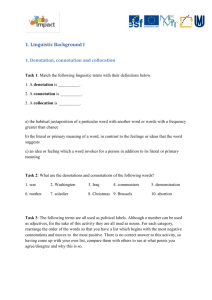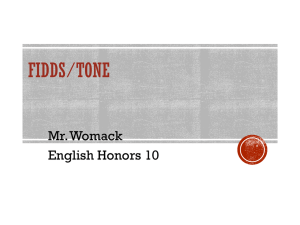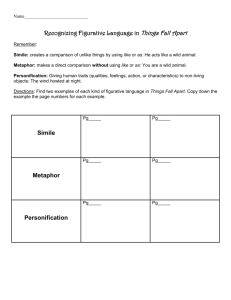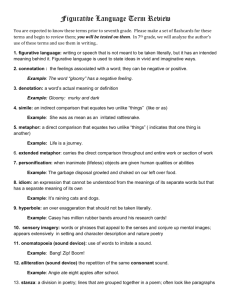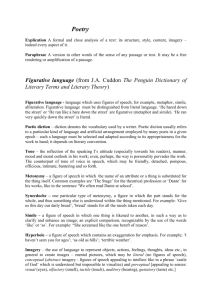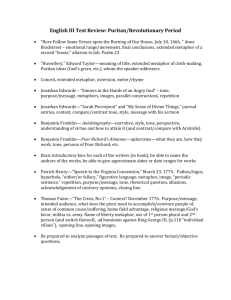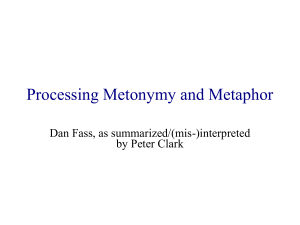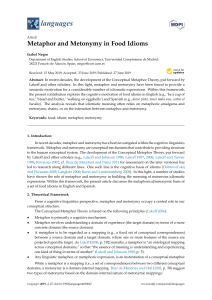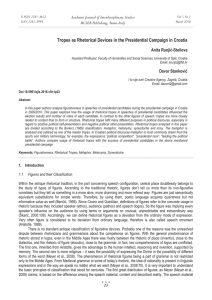Allusion: a figure of speech that makes a reference to, or a
advertisement
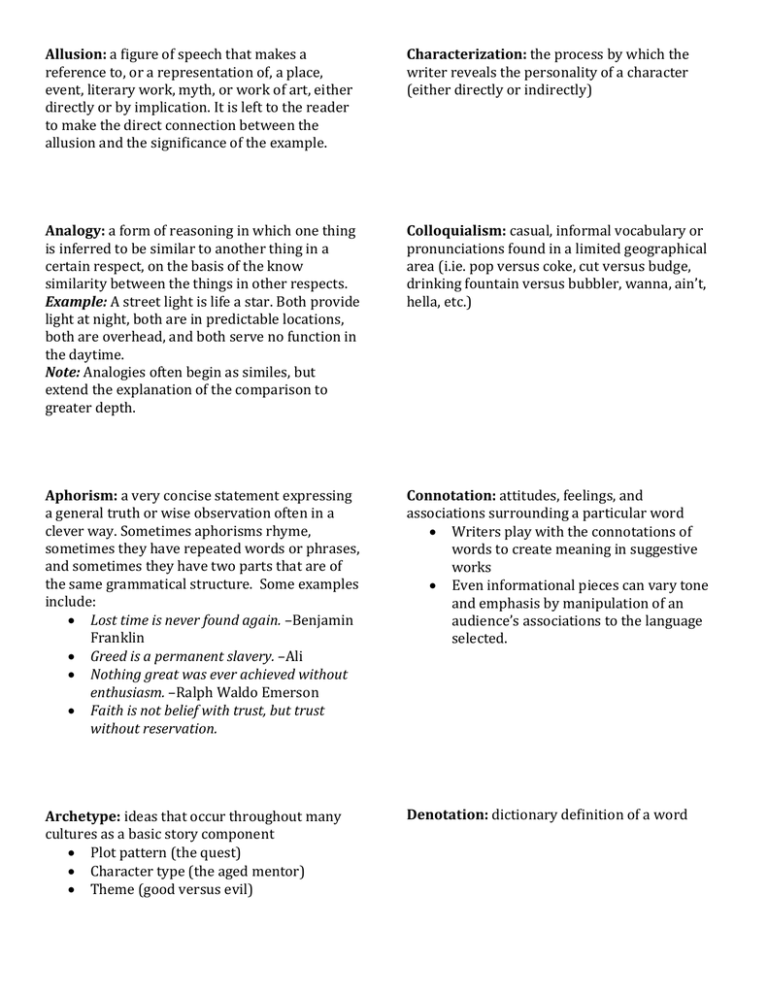
Allusion: a figure of speech that makes a reference to, or a representation of, a place, event, literary work, myth, or work of art, either directly or by implication. It is left to the reader to make the direct connection between the allusion and the significance of the example. Characterization: the process by which the writer reveals the personality of a character (either directly or indirectly) Analogy: a form of reasoning in which one thing is inferred to be similar to another thing in a certain respect, on the basis of the know similarity between the things in other respects. Example: A street light is life a star. Both provide light at night, both are in predictable locations, both are overhead, and both serve no function in the daytime. Note: Analogies often begin as similes, but extend the explanation of the comparison to greater depth. Colloquialism: casual, informal vocabulary or pronunciations found in a limited geographical area (i.ie. pop versus coke, cut versus budge, drinking fountain versus bubbler, wanna, ain’t, hella, etc.) Aphorism: a very concise statement expressing a general truth or wise observation often in a clever way. Sometimes aphorisms rhyme, sometimes they have repeated words or phrases, and sometimes they have two parts that are of the same grammatical structure. Some examples include: Lost time is never found again. –Benjamin Franklin Greed is a permanent slavery. –Ali Nothing great was ever achieved without enthusiasm. –Ralph Waldo Emerson Faith is not belief with trust, but trust without reservation. Connotation: attitudes, feelings, and associations surrounding a particular word Writers play with the connotations of words to create meaning in suggestive works Even informational pieces can vary tone and emphasis by manipulation of an audience’s associations to the language selected. Archetype: ideas that occur throughout many cultures as a basic story component Plot pattern (the quest) Character type (the aged mentor) Theme (good versus evil) Denotation: dictionary definition of a word Denouement: the final part of a play, movie, or narrative in which the strands of the plat are drawn together and matters are explained or resolved. From the French word to “unknot”. Don’t mistake with the climax— follows directly after the climax Considered a part of classical dramatic structure Some narratives have no denouement due to surprise or sudden endings Hubris: excessive pride. In ancient Greek tragedies, this is the most often cited character flaw that leads to the main character’s fall from a high position of power. Oedipus suffers from this trait in Sophocles’ play, Oedipus Rex (Oedipus the King) Diction: word choice Good readers will use the writer’s diction to recognize many of the other characteristics of a piece of writing Word choice is most directly liked to tone in nonfiction, but can also be used to identify audience, purpose, and theme In fiction, it is the diction that creates characterization, perpetuates suspense, or reveals a motif to the reader. Training your eyes to look for interesting diction will inevitable lead to strong analysis and a better understanding of meaning. Hyperbole: Way over excessive, humongous, gigantic, make-me-gag use of exaggeration Example: It has been a billion years since I have had time to watch TV after my homework is finished. Euphemism: the substitution of an agreeable or less offensive expression for one that may offend or suggest something unpleasant to the listener Force, police action, or conflict substituted for war Restroom for toilet Correctional facility for prison The big C for cancer Ethnic cleansing for genocide Idiom: a figurative expression not used in formal speech, often used primarily within a limited geographical or social setting. Different than slang or swear words in the sense that it is not rude, but would not be used in formal situations. “As the crow flies” “Dead as a doornail” “Raining cats and dogs” Figurative Language: language that is not intended to be interpreted in the literal sense. Imagery: the use of vivid or figurative language to represent objects, actions, or ideas. Imagery is language that appeals to any sense or combination of the senses. Dusty smell of winter hay dried and stored in the loft In medias res: An epic convention that means to begin in the middle of the story. The characters, setting, and conflict are often introduced through a series of flashbacks or through characters relating past events to each other. Classical work such as Homer’s Iliad and Virgil’s Adenoid begin in the middle of the story. Dante’s Divine Comedy also begins in medias res. Irony: the discrepancy between what is said and what is meant, what is said and what is done, what is expected or intended and what happens, or what is meant or said and what others understand. Juxtaposition: elements placed side by side for the act of comparison. This often applies more easily to visual images, but can be used in written prose and poetry. Metaphor: A figure of speech in which two unlike ideas are asserted to be the same by a direct comparison. (i.e. He is a bear today.) The man and the bear are unlike creatures, but their direct comparison conveys insight on the original object (the man). Metaphor is an overall umbrella under which terms like simile, metonymy, and synecdoche can be classified because they are all different methods of conveying that figurative metaphorical comparison. Metonymy: A figure of speech in which one thing is represented by another that is commonly and often physically associated with it. IT’s a specific type of metaphor in the sense that metaphor equates two ideas, but metonymy links the associated ideas so that one image conjures up an understanding of the other. Referring to someone’s handwriting as their hand Calling a monarch the crown Referencing the office of the President of the United States as the White House Motif: Unifying element in an artistic work, especially any recurrent image, symbol, theme, character type, subject, or narrative detail. Somewhat similar to an archetype, except not all motifs hold universal significance across cultures. Romeo and Juliet (the film version) utilizes water as a motif throughout the work Racism and innocence are concepts that reappear over and again in To Kill a Mockingbird Oxymoron: a figure of speech or word combination that contradicts Awfully good Natural make-up Jumbo shrimp Student teacher Paradox: A situation that looks to contradictory in nature, but actually possesses a universal truth. Standing in one spot all day at a job can actually be more tiring than moving around. o You would think that motion would create the exhaustion, but it’s actually the lack of motion that makes your muscles more tired. Parallelism: The use of successive verbal constructions in poetry or prose that correspond in grammatical structure or meaning. Parody: a work that imitates another work in order to ridicule, ironically comment on, or poke affectionate fun at the work itself, the subject of the work, the author or fictional voice of the parody, or another subject. Example from a British cartoon called Marvin the Paranoid Android Now I lay me down to sleep, Try to count electric sheep Sweet dream wishes you can keep, How I hate the night. Satire: Comedy with a purpose to make readers/viewers think. Generally exposes the faults of a society through mocking of its customs Mark Twain was a master of satire SNL sometimes has good examples of political satire Now the world has gone to bed, Darkness won’t engulf my head, I can see by infrared, How I hate the night. Personification: giving an inanimate object or abstraction human qualities or abilities. Oreo: milk’s favorite cookie The wind stood up and gave a shout. Simile: a comparison using like or as Repetition: the return of a word, phrase, stanza form, or effect in any form or literature. This is an effective literary device to bring comfort, suggest order, or add special meaning to a piece of literature. Symbol: an object, action, or person that represents an idea beyond its physical presence in the text. The key to distinguishing between symbol and metaphor is the physical presence of that object in the piece of literature. For example, in the Harry Potter series, Harry is physically given a mirror by Sirius through which they can communicate from separate areas. After Sirius dies, Harry repeatedly returns to the mirror for a glimpse of his godfather; this repeated action becomes a symbol for his longing for the parental figures that have left him behind in death. Rhetoric: The art of persuading through speaking and writing. Sometimes used in a modern sense to imply empty language. Rhetorical Question: Questions that are asked for the effect and do not require an answer. Questions asked for the purpose of directing listeners to a specific, simple answer. These questions are not to be answered literally. How many of you are willing to throw your freedoms away? Who wishes there were more hours in a day? Synecdoche: A figure of speech in which a part of something is used to represent the whole or, occasionally, the whole is used to represent a part. DIFFERENT than metonymy. To refer to a boat as a sail Referring to the basses in an orchestra as “the strings” In Elie Wiesel’s novel Night, the narrator calls himself “a body. Perhaps less than that even: a starved stomach.” Theme: The main message of the literature. The lesson to be learned from the piece. Always think of this in terms of a complete sentence written o explain a universal concept. Tone: The writer’s attitude toward his subject, characters, and/or audience. Think of emotion words here. Describe tone in terms of vocal variety and range of attitude. Examples: angry, sarcastic, loving, gentle, shy, bold mood: Atmosphere of a piece. Sensory words to describe the physical feeling of the world created by the writer. Describe mood using colorful adjectives. Examples: heavy, somber, light, dark, dense, suffocating Understatement: a form of speech in which a lesser expression is used than what would be expected. Understatement is a staple of British humor. For example, in Monty Python’s The Meaning of Life, a suburban dinner party is invaded by Death, who wears a long black cloak and carries a scythe. He is the Grim Reaper; the party is over; the guests must all go with him. “Well,” says one party guest, “that’s cast rather a gloom over the evening, hasn’t it?” in another scene, an Army officer has just lost his leg. When asked how he feels, he looks down at his bloody stump and responds, “Stings a bit.”
